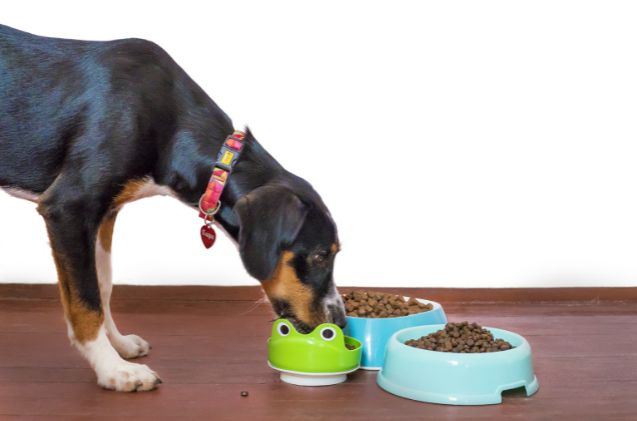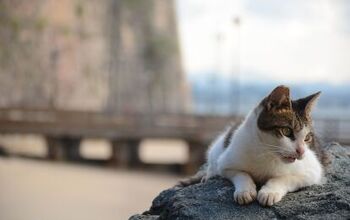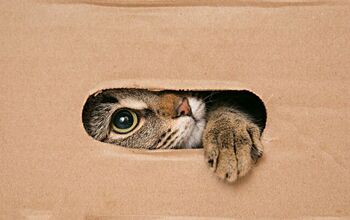Best Slow-Feeder Bowls

Do you have a dog or cat that eats so quickly that they sometimes make themselves sick? If so, you’re not alone! This is a problem faced by many pet owners, including both dogs and cats. For some, it happens because your pet loves their food so much that they gobble down their meal out of excitement. For others, it’s a response to challenges in their past, eating their food as quickly as they can out of fear of it being taken away or stolen by another animal. Regardless of the reason, slowing your pet down is important. Not only can eating too fast make your pet feel ill, but it can lead to some severe health complications. One effective solution is to introduce a slow-feeder bowl, a dish designed with obstacles your pet must work around to get to their food. This introduces mental enrichment, slows them down, and makes their meal fun. Here’s our list of the 10 best slow-feeder bowls to keep your pet safe during mealtime.
Editors Choice: Outward Hound Fun Feeder Slo Bowl
These simple plastic slow-feeder bowls from Outward Hound are a low-cost solution to slowing your dog down during mealtime. The bowls are available in 2 sizes. They are suitable for most pets; however, the deeper dish design may be complicated for those with shorter snouts. Outward Hound also offers multiple ridge patterns allowing you to keep their meals fun and engaging. A non-slip base prevents the bowl from sliding on the floor, while its dishwasher-safe design makes it easy to clean.
Pros
- Available in both small and large sizes
- Multiple designs to change up mealtime
- Dishwasher and freezer safe
Cons
- Deeper dish is difficult for pets with shorter snouts
- Plastic material can be damaged with use
Runner-Up: Mighty Paw Slow Feeder Dog Bowl
For aggressive eaters, slow-feeder dishes pose a unique risk – damage to their nose from trying to shove past the ridges to eat. This silicone dish is a great option to eliminate this problem. The bowl features 6 silicone waves to slow down eating. The bowl can be used on its own, or you can slide it into a standard stainless-steel bowl to use as a slow-feeder insert. A quick pull paw tab in the center of the dish makes it easy to remove from your dog’s bowl for cleaning.
Pros
- Bowl designed to work independently or as a bowl insert
- Silicone waves are easy on your dog’s nose
- Dishwasher safe
Cons
- Only available in one size, not suitable for smaller dogs
- Lightweight design makes it easy for dogs to pick up, slide, or knock over
Best Stainless Steel Slow-Feeder Bowl: Neater Pet Brands Stainless Steel Slow-Feed Bowl
Many slow-feeder dishes are made from lightweight plastic. For pet owners with a heavy chewer or destructive dog, this can make finding a solution that will last difficult. This stainless-steel bowl is durable and easy to clean. It can hold up to 3 cups of kibble, making it a great option for larger dogs. A single obstacle in the center forces dogs to slow down as they eat around it without being too complicated for dogs new to using slow-feeder dishes.
Pros
- Stainless steel is ideal for heavy chewers
- Non-tip and non-skid design
- Easy to clean/sanitize
Cons
- Deeper dish is difficult for pets with shorter snouts
- Single obstacle isn’t enough to slow down the most determined pets
Best Slow Feeder Insert: Fikz Craving Creativity Dog Bowl Insert Slow Feeder
If you are already using a dog dish or raised dog feeder you love, you may not want to switch your dog’s dish out entirely. However, if you already have a dog bowl that you’ve invested in, this is a budget-friendly alternative to replacing that bowl. The insert features 23 powerful suction cups to hold the insert in place and 5 larger silicone blades marked with lines making it easy to trim them to fit your dog’s dish, regardless of the size.
Pros
- Trim to fit any standard-sized dog bowl
- Silicone blades are easy on your dog’s nose
- Dishwasher safe
Cons
- Dog bowl must be purchased separately
- Isn’t as durable for heavy chewers
Best Ceramic Slow Feeder Bowl: Le Tauci Ceramic Slow Feeder Dog Bowl
Most veterinarians recommend using a ceramic dish for dogs or cats that suffer from acne. This can complicate things if you also want to incorporate a slow feeder into your mealtime. This dish’s weight and the non-slip bottom will prevent the dish from sliding. The ceramic material is easy to clean, and it’s both dishwasher and microwave safe. This makes the Le Tauci dishes suitable for kibble and wet food.
Pros
- Ceramic material to prevent canine/feline acne
- Durable, chew-resistant design for heavy chewers
- Heavy material prevents dogs from picking it up or dumping it
Cons
- Ceramic is more likely to break if the dish is dropped
- Heavier for those looking for a dish that also accommodates travel plans
Best Slow Feeder Bowl for Short-Snouted Pets: Leashboss Flat Face Feeder
Brachycephalic pets have flatter faces and shorter snouts than other breeds. Some examples of pets that fall into this category include Persian cats, French bulldogs, Boston terriers, and Pugs. As a result of their short snout, they may find it difficult to reach food in deeper food dishes. Recognizing this, Leashboss created a slow-feeder dish that accommodated their short snouts with a shallow design that has a slight incline to allow for easy access to all corners of the dish.
Pros
- Shallow food compartments and a slight incline
- Dishwasher safe
- 100% BPA, PVC, and Phthalate-free
Cons
- Only holds 1.5 cups for smaller short-snouted pets
- Lightweight design moves too easily during use
Best Lick Mat Slow Feeder: LickiMat Slomo Combo Slow Feeder/Treat Maker
A lick mat is a fun alternative to a traditional slow feeder bowl. These flat mats with groves and textures hold your pet’s wet food or other soft, spreadable treats. Lick mats are a favorite of veterinarians and groomers because licking has a calming effect. It helps to eliminate boredom and reduce anxiety. The food compartments on a lick mat are shallower than a standard bowl, making it easier for smaller pets and those with short snouts.
Pros
- Vet-developed and animal behaviorist approved
- Freezer, microwave, and dishwasher safe
- BPA, PVA, and silicone-free
Cons
- Shallow design isn’t suitable for larger amounts of kibble
- Easily slides on slippery surfaces like tile floors
Best Slow Feeder Dish for Cats: Fatcatjoy Ceramic Plate Cat Slow Feeder Bowl with Wood Stand
Like dogs with shorter snouts, cats often have a harder time with deep food dishes. This ceramic dish from Fatcatjoy is an excellent choice for smaller pets. The ceramic dish is both dishwasher and microwave safe. It rests upon a wooden stand, making it more comfortable for senior pets and those that struggle to reach down to food on the ground. However, the elaborate design of the dish can make it more challenging to clean.
Pros
- Flat ceramic dish helps to prevent feline acne and whisker fatigue
- Dish can be used with or without ceramic dish depending on your cat’s needs
- Suitable for both wet food and kibble
Cons
- Small size suitable only for cats or small dogs
- Elaborate design is harder for cleaning purposes
What is a Slow-Feeder Bowl?
Slow-feeder dishes are pet food bowls that incorporate obstacles that slow your pet down when eating. This is because they can’t take large mouthfuls all at once. Instead, they can only take small amounts at a time. Most slow-feeder dishes accomplish this by incorporating raised walls or sections within the dish. They are available in a wide variety of different sizes and materials, including plastic, stainless steel, and ceramic.
Do Slow-Feeder Dishes Prevent Bloat?
Before looking at slow-feeder dishes for pets and their ability to prevent bloat, we need to discuss the basics of bloat in pets. Gastric Dilation-Volvulus, or bloat, refers to the build-up of gas, food, or fluid in a dog’s stomach. As a result of this accumulation, the stomach twists, creating an emergency that can quickly turn fatal.
There are several risk factors to consider when trying to reduce bloat in your pet. This includes the speed at which our pet eats, their physical activity immediately after eating, how much they drink just after eating, and the biological risk factor associated with certain dog breeds.
Introducing a slow-feeder dish to your dog won’t guarantee they aren’t at risk for bloat. By slowing your dog down, it helps to limit the amount of air that they are inhaling while ingesting their food. This helps to reduce the chances of the stomach becoming filled with air during mealtimes.
Can Dog Bloat Resolve on Its Own?
If you believe that your pet may be experiencing bloat, this is a medical emergency. The most common warning signs of bloat include:
- Retching or attempts to vomit unsuccessfully
- Excessive drooling
- Pacing
- Rapid breathing
- Restlessness
- Swollen abdomen
- Collapse
Bloat can quickly turn fatal when not addressed. The sooner you get them to a veterinarian, the better their chances of survival. In true cases of bloat, this often requires surgery known as “gastropexy.” If treatment isn’t provided quickly enough, euthanasia may be the only option.
How to Choose the Best Slow-Feeder Dish for Your Pet
Style
Several types of slow-feeder dishes are available depending on your pet’s size and the kind of food they eat. Standalone bowls are the most common option. These are traditional bowls with an obstacle of some form inside. Obstacles could include ridges, bumps, or a larger raised center. Slow-feeder inserts are just the obstacle portion of the feeder and need to be used with your pet’s existing bowl. This is a great option if you have a fancy dog feeding dish that you want to keep. Finally, lick mats are designed for wet food and spreadable treats. They are a very shallow feeder with different textures that your pet must lick around to get their food.
Size
When selecting the correct dish size, several important factors must be considered. First, look at how much food the dish is designed to hold. If you have a larger dog, a 1-cup dish will not provide enough space for their meal. Second, look at the height of the dish and whether your pet can reach into the dish to eat comfortably. If your pet suffers from arthritis or other joint-related struggles, consider a raised dish. This makes it easier for them to eat by limiting how far they need to reach down.
Material
The most common slow-feeder materials are plastic, silicone, ceramic, and stainless steel. Each of these materials offers its own benefits and challenges. Plastic and silicone dishes are lighter, making them more convenient for travel. But they are easily lifted or moved around. Plastic dishes also show wear and tear much earlier from regular use. The scratches in a plastic dish are a breeding ground for bacteria, meaning that these dishes must be replaced more frequently. Silicone is an excellent option for overly excited eaters that may risk hitting their snout on the dish while eating. Ceramic dishes offer the heaviest weight and high durability. They last longer than plastic dishes, but they also cost significantly more. Stainless-steel dog dishes are the easiest to disinfect.

Britt Kascjak is a proud pet mom, sharing her heart (and her home) with her “pack” which includes her husband John, their 2 dogs – Indiana and Lucifer – and their 2 cats – Pippen and Jinx. She has been active in the animal rescue community for over 15 years, volunteering, fostering and advocating for organizations across Canada and the US. In her free time, she enjoys traveling around the country camping, hiking, and canoeing with her pets.
More by Britt































